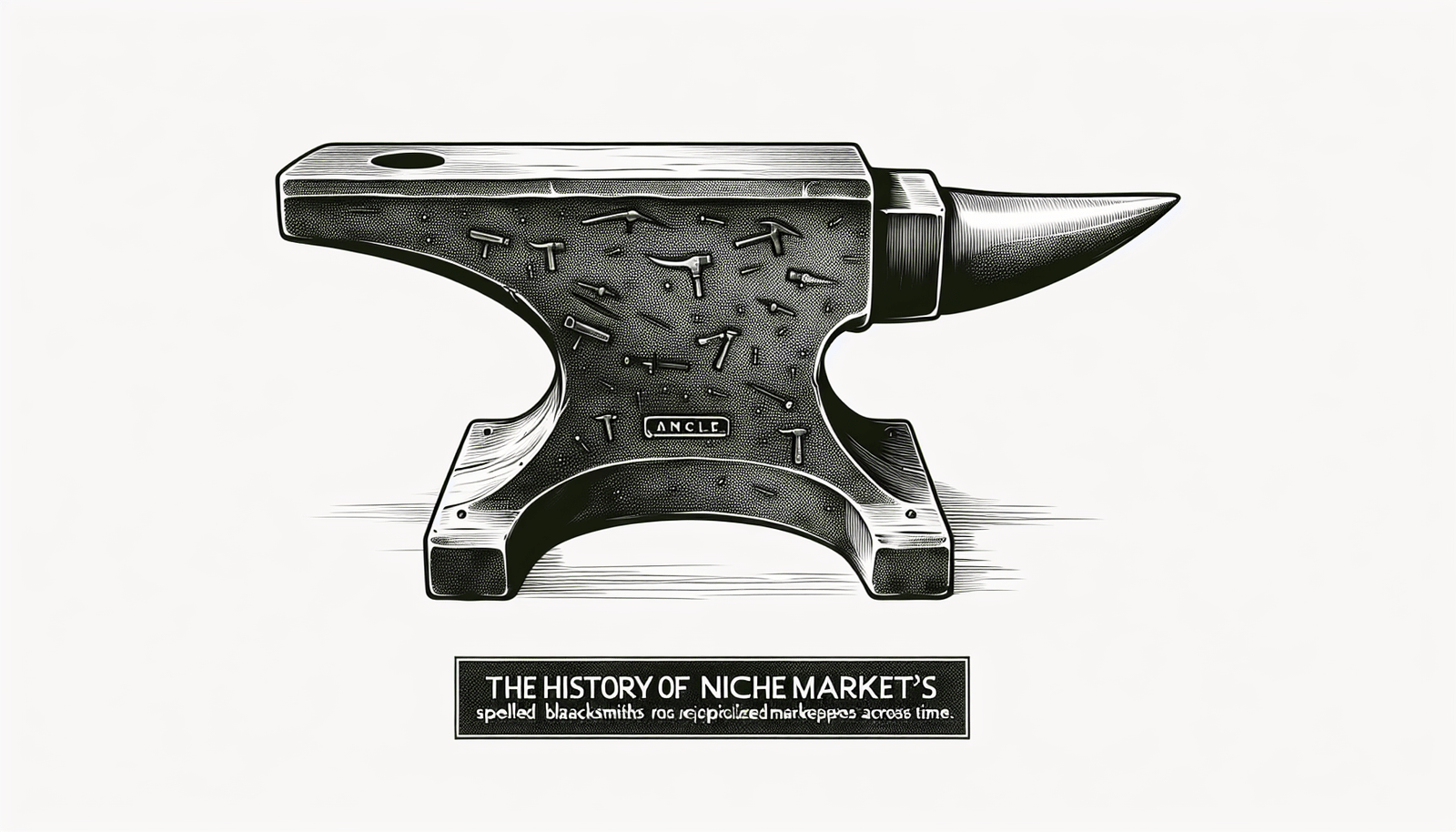Exploring The History Of The Niche
Have you ever wondered how certain things become popular and develop into their own unique spaces? In this article, we will take a fascinating journey into the history of the niche, uncovering the origins and evolution of these specialized pockets in various industries. From fashion to technology, we will explore the factors that have shaped niches over time and how they continue to thrive in our modern world. Join us as we dig into the intriguing past of the niche and discover the stories behind these captivating pockets of interest.
Ancient Origins
Early Examples of Niche Markets
In ancient civilizations, there were already glimpses of niche markets emerging. Soldiers, for example, needed specialized armor and weapons. Blacksmiths who focused solely on producing these items found themselves catering to a niche market. Similarly, in the agricultural sector, farmers who specialized in breeding certain livestock or growing specific crops were serving niche markets. These early examples demonstrate the existence of specialized crafts and trades that catered to specific needs and preferences.
Development of Specialized Crafts and Trades
As civilizations developed, the need for specialized crafts and trades grew. This led to the establishment of skilled artisans and craftsmen who focused on their respective niches. Whether it was jewelry-making, pottery, or carpentry, these specialized artisans brought their unique skills and expertise to their work. This development not only enriched the quality and variety of available products but also fostered pride and dedication among artisans in their specialized fields.
Medieval Guilds
Formation and Purpose of Guilds
In the medieval period, guilds played a crucial role in regulating and organizing niche trades. Guilds were associations of skilled craftsmen and artisans who shared the same trade. These guilds set standards for quality, protected the interests of their members, and ensured fair competition. The purpose of guilds was not only to safeguard the integrity of their respective trades but also to provide training and support for apprentices and journeymen. By organizing themselves into guilds, artisans and craftsmen formed cohesive communities that nurtured their specialized skills.
Regulation and Control of Niche Trades
Guilds were instrumental in controlling niche trades and maintaining a guild monopoly. They were responsible for implementing regulations and overseeing the quality of products and services within their trade. Guilds also had the authority to set prices and wages, ensuring fair compensation for their members. While this control protected the interests of guild members, it also limited opportunities for newcomers to enter these niche markets. Nonetheless, guilds played a significant role in preserving the standards and traditions of their respective trades.
Industrial Revolution
Mass Production and the Rise of Mass Markets
The Industrial Revolution brought about a significant shift in the market dynamics. With the advent of mass production techniques, products became more affordable and accessible to the general population. This led to the rise of mass markets, where mainstream goods catered to the needs of a large consumer base. The focus shifted from niche trades to mass production of standardized products, as factories sought to meet the growing demands of the industrial era.
Emergence of Niche Industries
However, even amidst the surge of mass markets, niche industries continued to thrive. As the Industrial Revolution progressed, certain industries began recognizing the value of catering to specific consumer preferences and tastes. Specialized products emerged, targeting niche markets that desired unique or customized offerings. This marked the beginning of a new era for niche industries, as they shifted from the traditional craftsmanship model to a more market-driven approach.
20th Century
Niche Marketing and Targeted Advertising
The 20th century witnessed a significant evolution in niche marketing strategies. With the advancement of communication and media technologies, businesses began recognizing the value of targeted advertising. Instead of aiming to reach a mass market, companies identified specific niche segments and tailored their marketing messages accordingly. This personalized approach allowed them to connect with their target consumers on a deeper level, addressing their unique needs and preferences.
Niche Industries in Fashion and Entertainment
Fashion and entertainment industries saw a notable rise in niche markets during the 20th century. Designers and artists started exploring unconventional styles and genres that appealed to specific subcultures. This led to the emergence of iconic fashion subcultures and underground music scenes. Niche trends such as punk, grunge, and hip-hop became influential in shaping mainstream culture. The fashion and entertainment industries thrived on the diversity and creativity offered by niche markets, catering to individuals who sought alternative forms of expression.
Digital Age
E-commerce and the Expansion of Niche Markets
With the advent of the digital age, e-commerce platforms revolutionized the way niche markets operate. Online platforms provided a global marketplace for niche products and services, enabling businesses to reach a vast audience without physical limitations. Niche markets that were once confined to local communities now had the opportunity to grow and expand on a global scale. This digital expansion allowed niche businesses to connect with their target consumers directly, fostering a sense of community and loyalty.
Influence of Social Media on Niche Communities
Social media platforms further fueled the growth of niche communities. These platforms provided a space for individuals with similar interests to connect, share, and support each other. Niche influencers emerged, gaining substantial followings and becoming tastemakers within their respective communities. This shift from traditional advertising to influencer marketing allowed niche markets to reach a wider audience and connect with consumers on a more personal level. Social media became a powerful tool for niche industries to showcase their products, receive feedback, and foster a sense of belonging among their followers.
Impact of Globalization
Cultural Exchange and the Spread of Niche Trends
Globalization played a significant role in the spread of niche trends across different cultures. As travel and communication became more accessible, cultural exchange became more prevalent. Niche trends and subcultures from one region found their way to distant corners of the world, appealing to like-minded individuals. This cross-pollination of niche trends led to the blending of cultural influences and the emergence of unique hybrid subcultures.
Cross-Cultural Adaptation in Niche Industries
Niche industries had to adapt to the challenges and opportunities presented by globalization. Traditional niche markets confronted new competition from international players, requiring them to innovate and diversify. Some niche industries embraced cross-cultural collaborations, combining traditional craftsmanship with modern design aesthetics. By adapting and incorporating elements from different cultures, these industries thrived on the diversity of global influences while maintaining their niche identity.
Niche Today
The Growing Popularity of Niche Products and Services
In recent years, the popularity of niche products and services has continued to rise. Consumers are increasingly seeking unique and personalized experiences, moving away from mass-produced offerings. Niche industries have gained prominence, offering products and services that cater to specific needs, values, and lifestyles. The allure of niche lies in the attention to detail, quality, and individuality that these products and services provide, resonating with discerning consumers who prioritize authenticity and differentiation.
The Role of Niche Communities in Shaping Markets
Niche communities play a pivotal role in shaping markets today. These communities are formed by individuals who share common interests, values, or lifestyles and actively engage with niche industries. By providing feedback, recommendations, and support, these communities influence the direction and success of niche businesses. Niche industries often rely on the loyalty and enthusiasm of their community members, fostering a sense of shared identity and purpose.
Subcultures and Countercultures
Niche as a Form of Cultural Expression
Niche markets and subcultures continue to be vehicles for cultural expression. Whether it’s alternative fashion styles, underground music genres, or unconventional art movements, niche cultural expressions challenge mainstream norms and offer alternatives to dominant narratives. These subcultures provide individuals with a sense of belonging and self-identity, allowing them to express themselves authentically and assert their individuality.
Resistance and Alternative Values
Niche markets often embody resistance and alternative values. They serve as a platform for marginalized voices and provide an outlet for individuals who reject mainstream ideologies. Niche industries rooted in countercultures challenge established power structures, advocating for social change and promoting inclusivity. The resistance and alternative values within niche markets create spaces for dialogue, activism, and the exploration of new paradigms.
Challenges and Opportunities
Balancing Authenticity and Commercial Viability
One of the challenges niche industries face is striking a balance between authenticity and commercial viability. As niche businesses aim to grow and expand their reach, they may encounter pressures to compromise their core values and uniqueness. Successful niche brands navigate this challenge by staying true to their identity while strategically adapting to market demands. By maintaining their authenticity, niche industries retain the trust and loyalty of their community members while attracting new customers drawn to their distinct offerings.
Navigating Competition in Niche Industries
Competition within niche industries can be fierce. As niche markets gain popularity, more players enter the scene, offering similar products or services. Niche businesses must find ways to differentiate themselves and stand out in an increasingly crowded market. This can be achieved through innovation, quality, exceptional customer service, and fostering strong relationships with their community. Collaboration and strategic partnerships can also help niche businesses leverage each other’s strengths and collectively thrive in a competitive landscape.
Future Trends
Technological Advancements and Niche Innovations
Technological advancements will continue to shape the future of niche markets. As new technologies emerge, niche industries will find innovative ways to incorporate them into their products and services. For example, advancements in 3D printing may allow for customized production on a larger scale without compromising quality. Virtual and augmented reality technologies may provide immersive experiences within niche industries, offering unique interactions and enhancing customer engagement.
Sustainability and Ethical Practices in Niche Markets
The growing concern for sustainability and ethical practices will significantly influence niche markets in the future. Consumers increasingly demand transparency, responsible sourcing, and eco-friendly options from the brands they support. Niche industries, with their emphasis on quality and authenticity, are well-positioned to embrace sustainability as a core value. By adopting environmentally friendly practices and prioritizing ethical production methods, niche businesses can align themselves with the values of conscious consumers and contribute to a more sustainable future.
In conclusion, the history of the niche is a testament to the resilience and creativity of human ingenuity. From ancient origins to the modern-day, niche markets have evolved and thrived, catering to specialized needs, expressing unique identities, and challenging mainstream norms. As we look to the future, niche industries will undoubtedly continue to shape markets, offering personalized experiences, fostering communities, and driving innovation. The niche is not just a market segment; it is a space for self-expression, resistance, and the exploration of new frontiers.


